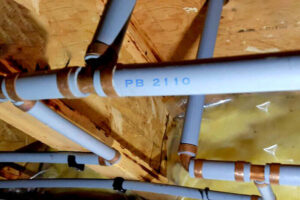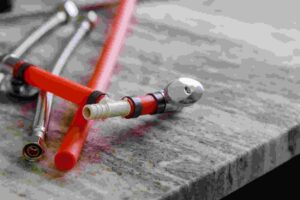Polybutylene Plumbing: What Homeowners Must Know
People once thought that polybutylene plumbing was a cool new way to bring water into homes. But over time, it got a bad name for having problems that were hard to fix and cost a lot of money to keep your home safe, you should know about the risks of polybutylene plumbing, the different types of repairs, and why it breaks.
What Is Polybutylene Plumbing?
This term was applied to water pipes composed of the plastic polybutylene (PB) between the late 1970s and the mid-1990s. Because the lines and Polybutylene Fittings were less expensive and simpler to set up than copper phone lines people purchased them.

Key characteristics include:
- Stretchy and typically colored black, grey, or blue
- In many houses across the United States, Canada, and the United Kingdom.
- Often ranging from 3/8″ to 1″ in circumference.
Why Was Polybutylene Popular?
Because it offered several benefits at the time, polybutylene rose to fame:
- Lower Cost – Copper pipes are more costly.
- Ease of Installation – Might be assembled rapidly with fewer components.
- Corrosion Resistance – Initially, the intention was to prevent size accumulation.
- Lightweight – It facilitates movement and handling.
Due to subsequent reliability issues, these gains were rendered less significant.
Problems with Polybutylene Plumbing
Polybutylene plumbing started to break down in many homes, even though it got good reviews at first. Because of this, there were leaks, water damage, and expensive repairs.
1. Chemical Degradation
Chlorine and other disinfectants in public water systems may react with polybutylene, leading to hardness and eventual cracking over time.
2. Fitting Failures
Certain PB systems incorporated vinyl acetal joints; however, these joints were prone to failure.
3. Hidden Leaks
If there are line breaks behind walls or under floors, they might not be found until they’ve done a lot of damage.
4. Insurance Challenges
Many insurance companies do not cover homes that have polybutylene plumbing since it has been known to fail in the past. This is the major reason why many insurance companies do not cover homes that have this type of plumbing.
Indications That Polybutylene Pipes May Be in Your Home
Take note of these visual cues:
- Pipe Colour: The colours blue, black, and grey are the ones that are seen the most frequently throughout the world.
- Stamped Code: The exposed section of the pipe shows the marking “PB2110.”
- Location: Common places to find them are crawl spaces, basements, water heaters, and sinks.
Risks of Keeping Polybutylene Plumbing
- Water Damage Costs – Repairing a busted pipe might end up costing a pretty penny.
- Property Value Impact – PB plumbing could make a house less valuable when it’s time to sell it.
- Increased Insurance Premiums – Higher insurance rates or even being turned down outright.

Replacement Options
Installing new lines is advisable if your home has polybutylene sewers.
Popular alternatives include:
- PEX (Cross-linked Polyethene): It features resistance to chlorine, along with durability and flexibility.
- Copper: Although it may be pricier, its durability is greater.
- CPVC (Chlorinated Polyvinyl Chloride): It is affordable and does not convert into chlorine.
Cost to Replace Polybutylene Plumbing
- Average Cost: From $2,000 to $15,000, depending on the square footage of the house, the materials selected, and the labour cost.
- Factors Influencing Cost:
- How many square feet does your house have?
- Reaching the pipelines
- Materials selected for use as an alternative
- Pricing for nearby projects
Female Plumbing Services offer trustworthy and affordable solutions for replacing old pipe systems with the help of qualified professionals.
Preventive Measures If Replacement Isn’t Immediate
If you find yourself unable to acquire new PB plumbing immediately, please follow these steps:
- Reduce water flow to reduce pipe stress.
- Put in a whole-house water filter to cut down on chlorine exposure.
- Regular plumbing inspections make it simpler to find leaks early.
Conclusion
Pipes made of PVC are not safe and should not be used in many older homes. It might still work but it’s not a good idea for any property because it has led to chemical damage leaks and problems with insurance in the past. Putting in new copper or Polybutylene vs PEX lines will make you feel better protect your house and save you money in the long run.
FAQs About Polybutylene Plumbing
Q1: Is polybutylene plumbing still used today?
It stopped being made in the mid-1990s because quite a few people encountered issues with it.
Q2: Can I sell my house with polybutylene pipes?
Sure, but you gotta let buyers know, and it might bring down your home’s value.
Q3: How long do polybutylene pipes last?
A lot of them broke down in 10–15 years, even though they were meant to last 50 years.
Q4: Will homeowners insurance cover leaks from PB plumbing?
A lot of insurance companies won’t pay claims or cover homes with live PB systems.
Q5: Should I replace my PB plumbing immediately?
Yes, if you can. Replacing it is the best way to avoid sudden leaks and expensive damage.